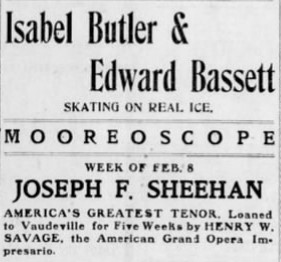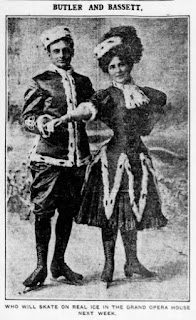Imagine a turn of the century automobile careening down a curved roller coaster track, doing a full loop in the air over a forty foot chasm and flying onto another track. That was Butler's job in Barnum and Bailey's Circus in 1906 and 1907. The stunt was reportedly based on an act called "L'Auto-Bolide" that was spotted by an agent in Paris, France. It was brought over to America as The Dip Of Death by one Mademoiselle Mauricia De Tiers. Her successor Isabella, the young mother from Boston, performed it twice daily for two years, holding a fan in one hand and driving with the other. She told reporters, "It is disagreeable - the sensation, I mean. It only lasts four seconds, but I experience a painful sensation in the moment I am going over the curve, upside down, just before the leap in the air. I feel as if I were choking and I suffer quite a severe pain in the head which does not disappear entirely during the evening. But I have no fear. I don't know what it means. I have great faith in the skill of the engineer who constructed the apparatus, and I have the satisfaction of knowing that if the machine ever does fall I shall not be maimed or disfigured for life. I shall simply be skilled outright, for no one could live after that car fell."
If that's not crazy enough for you, how would you feel if I told you we were just getting started? After studying medicine at Vassar College in New York, Isabella married Tom Butler, a divorced champion stunt bicycle rider originally from Halifax, Nova Scotia. It was through Tom's circus connections that she got the Barnum job. After two years of performing The Loop Of Death, she yearned to pursue her real passion: figure skating.
The daughter of Hattie (Baskerville) and George Henry Allen, Isabella grew up in Chicago. She learned the basics of the ice skating at the age of seven on a frozen pond in Garfield Park from Alderman John E. Scully and started pursuing the sport seriously at the St. Nicholas Rink in New York in 1903. In 1906 - the same year Madge Syers won the first ISU Championship For Ladies - she sent in an application to compete in the Championships Of America at the urging of friends. It was the first time a woman had expressed an interest in competing against the 'gentlemen', and the International Skating Union Of America flatly denied her request. A year and a half later, she teamed up with Eddie Bassett, who'd won a fancy skating competition at the St. Nicholas Rink in March of 1907.
Butler and Bassett became a hugely popular Vaudeville figure skating act that took America by storm for the better part of a decade. Tom Butler travelled with the duo, making artificial ice for their stage performances and closely guarding the secret to how he did it to reporters and curious audience members alike.
Boston born circus star and impresario Stanley W. Wathon promoted Butler and Bassett, falsely billing them as the "World's Champion Skaters" to draw in patrons. The ruse worked. Patrons flocked en masse to the Fifty Eighth Street Theatre in New York City to see what all the fuss was about. "The New York Clipper", on March 14, 1908 recalled their act thusly: "A tank of real ice, about eight or ten feet in length by half of that in width is set in the centre of the stage, and on this the team perform their skating novelties. The act opens with some neat evolutions by both Miss Butler and Mr. Bassett and then each takes an individual try at it, with capital results. They do some remarkable feats, particularly when the small space in which they are compelled to work is taken into consideration. Miss Butler aroused plenty of enthusiasm and Mr. Bassett's skating around four lighted candles brought forth hearty applause. The entire act is worthy of the highest praise, and is something new for Vaudeville. It ran about twelve minutes, in three... He introduces a marvellous human top spin, in which he claims to spin at the rate of several hundred revolutions a minute." Following their Big Apple debut, Butler and Bassett took their icy stage act on the road to Chase's Theatre in Washington, D.C., The Grand Theatre in Pittsburgh and Bennett's Theatre in Montreal between May 1908 and January 1909.
Over a decade before the nineteenth amendment guaranteed American women the right to vote, Isabella Butler was personally responsible for teaching New York women to figure skate. These 'skating suffragettes' were largely members of the city's upper crust. On April 21, 1909, The Bridgeport Evening Farmer reported on her classes and skating thusly: "Desiring to interest her sex in the sport she yielded to the entreaties of Mrs. Irving Brokaw and Mrs. Ernest Iselin and had a class at the St. Nicholas Rink which did more to create the interest in ice skating among the women of New York than anything else had done for several years. Miss Butler expressed a desire to enter the world's skating contest last year but the cruel men debarred her because of her sex. She has challenged all of the prominent women skaters of this country and Canada to contests but they have not seen fit to risk defeat." Considering the laws surrounding amateurism in competitive figure skating in those days, one might construe the latter statement about Butler wishing to compete as a bit of 'enthusiastic journalism' or another Wathon story told to draw in patrons, but we weren't there. Who knows what her intentions truly were? At any rate, it's fascinating history.
Bassett and Butler continued to perform their act in theatres from Chicago and Memphis to San Francisco and Sacramento. When they weren't on the road, they practiced on the ice separately: Bassett at the Crystal Ice Rink in St. Louis and Butler at The Elysium Rink in Cleveland. In 1912, Isabella spent a winter teaching skating at the Connaught Club in Victoria, British Columbia.
Isabella also skated singles and pairs with none other than Norval Baptie, whose story we looked at on the blog back in July of 2014. The Duluth Herald, reporting on her performance in a show with Baptie at the Duluth Curling Rink in Minnesota in February of 1911 noted, "Her form is faultless, and form counts most in figure skating, and she executes the most difficult figures with the greatest of ease. Miss Butler goes through the entire repertoire of fancy figure skating, showing remarkable control and wonderful ease in every move she makes. Her work last evening was greeted with a round of applause that must indeed have pleased her." By 1915, Butler and Bassett were skating alongside Gladys Lamb and Norval Baptie in the "Castles In The Air" shows at The Ice Palace above the Forty Fourth Street Theatre in New York City, executing complex figure eights and novel spins while diners guzzled back cocktails between six and nine over supper. The next winter, she was in Los Angeles on a five month contract ice skating at the Hotel Alexandria with her sister Grace and Irish born Australian skating pioneer Dunbar Poole.
Roman Mars aptly mused on the podcast 99% Invisible that "it's totally unfair. Hydrox cookies came out four years before the introduction of Oreos, but Hydrox could never shake the image that it was a cheap knock-off, an also-ran. As a consumer product, it's completely out of your hands if you're deemed a mighty Transformer, or a loathsome Gobot. Sometimes it doesn't make any sense at all."
The documented history of figure skating has for years worked very much the same way. Madge Syers in, Mabel Davidson out. Sonja Henie in, Belita out... Isabella Butler out. A university educated mother who jumped "The Dip Of Death" with Barnum And Bailey, toured America skating on artificial ice and taught women to skate before they could vote... forgotten. Sometimes it doesn't make any sense at all.
Skate Guard is a blog dedicated to preserving the rich, colourful and fascinating history of figure skating. Over ten years, the blog has featured over a thousand free articles covering all aspects of the sport's history, as well as four compelling in-depth features. To read the latest articles, follow the blog on Facebook, Twitter, Pinterest and YouTube. If you enjoy Skate Guard, please show your support for this archive by ordering a copy of the figure skating reference books "The Almanac of Canadian Figure Skating", "Technical Merit: A History of Figure Skating Jumps" and "A Bibliography of Figure Skating": https://skateguard1.blogspot.com/p/buy-book.html.











